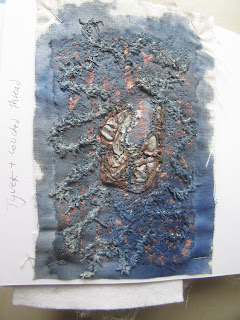Irene wrote to me about giving a lesson on using Tyvek in embroidery. I don't teach workshops any more because I haven't the energy and it distracts me from my own personal work so giving a blog lesson seems to be an experimental answer to passing on the knowledge.
Tyvek is a plastic used in the building industry and for envelopes. ( and craft) It comes in flat sheets and you iron it gently between 2 sheets of baking parchment and it shrivels up. BUT YOU NEED A FACE MASK because like any plastic it gives off toxic fumes - open all the windows or iron near an open door. Also beware getting it onto your iron hence the layers of baking parchment. Not my favourite thing because we need to stop using plastic but here are my samples from my machine embroidery sketchbook made about 15 years ago. Sample of Tyvek after heat applied top left.
It can be coloured with acrylic paints- water colour doesn't work - here I have used metallic acrylics, I think oil pastels work too - you need a thick pigment to take on the plastic. Sample with couched textured thread.
It then can be stitched into with machine or hand embroidery, bearing in mind like all stitching on paper you leave a hole when the needle goes through - so no mistakes or stitch over mistakes.The above sample is whip stitch on Tyvek. Silver outside border is tissue paper on calico.
Probably best used in very small patches and integrated with texture stitches.Sample is on felt -machine and hand embroidery.Spot the 2 small patches of Tyvek!
Scrunched up tissue paper can be used instead of Tyvek - it is safer and more eco-friendly! Have fun experimenting with different things to create textures in embroidery - but be led by the form you wish to create ( lichen, tree bark etc) rather than the material. Always start with drawing to really observe what you want to portray. Hope this is helpful Irene.





I really try to avoid toxic fumes ever since the time I used a pyrography tool on chrome tanned leather and in the same year used an antiquing medium for the edges of a grimoire and then decided to burn them... have learned that toxic fumes are definitely poisonous!
ReplyDeleteYes best to leave alone really, there is lots of safer stuff around. Lace will give good texture instead.
ReplyDeleteVery interesting blog. Alot of blogs I see these days don't really provide anything that I'm interested in, but I'm most definately interested in this one. Just thought that I would post and let you know.Tyvek Suit
ReplyDeleteAlthough this method is still widely used today, there are also some kinds of embroidery patches that can be stuck to material without the use of a needle and thread. get information
ReplyDelete